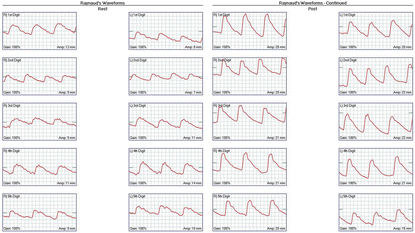Upper limb ischemia etiologies
1. Atherosclerosis
2. Autoimmune/connective tissue disorders
3. Buerger’s Disease
4. Embolization
5. Vibration/occupational
6. Dialysis access steal
7. Thoracic Outlet Syndrome (TOS)
8. Trauma
9. Frostbite
Raynaud’s Syndrome
Raynaud’s Syndrome is a vasospastic disorder that exhibits an exaggerated response to cold or emotional stimuli (Fig. 4.1). This response induces hand pain, numbness, and color changes from paleness to cyanosis to rubor. It occurs more frequently in upper than lower extremities and is more prevalent in colder climates (15–20 % versus 2–3 %).


Fig. 4.1
Reversible vasoconstriction with thermal maneuvers consistent with Raynaud’s phenomenon in the left hand.
1.
Primary Raynaud’s Disease: Abnormal vasospatic response without underlying systemic conditions
2.
Secondary Raynaud’s Phenomenon: Usually associated with an underlying arterial disease or connective tissue disorder with a fixed vascular obstruction and superimposed vasospasm.
Connective Tissue Disorders (Scleroderma, CREST, Systemic Lupus Erythematosus)
Usually affects small vessels and is due to cellular proliferation and fibrin deposition that leads to luminal narrowing. Patients can present with symptoms that range from simple Raynaud’s phenomenon to frank digit gangrene. In patients undergoing angiography, extensive small artery occlusion affecting arteries of the palmar arch and digits is usually observed.
Occlusive Disease
Occlusive disease is the most common etiology, but only represents <5 % of all cases of limb ischemia.
Atherosclerosis
Usually affects large arteries and arch vessels and frequently is asymptomatic. Diabetic patients and those with chronic renal failure may have an accelerated atherosclerotic process.
Embolic Disease
Embolism is the most common cause of acute upper extremity ischemia and has a cardiac origin in 75 % of patients. The etiology of cardiac emboli is atrial fibrillation in 50 % of cases.
Buerger’s Disease
Buerger’s Disease is a non-atherosclerotic inflammatory vasculopathy that affects medium-sized vessels primarily (infrabrachial). It is most common in young male smokers, although this pattern is changing as more women smoke. The etiology and pathophysiology remains unclear but is thought to be secondary to an immune reaction that leads to endarteritis and ultimately, thrombotic occlusion of upper- and lower-extremity arteries. In the acute phase, there is neutrophilic inflammation with preservation of the internal elastic lamina, and in the late stage there is perivascular fibrosis and organization of the occlusive thrombus.
Inflammatory Arteriopathies
Takayasu’s and Giant Cell Arteritis are the two entities that most commonly affect the upper extremities. Takayasu’s is the most common and tends to affect the aorta and major branches. Young Asian females are typically affected. Giant Cell Arteritis most commonly affects the carotid branches (subclavian and axillary are involved in 10–15 %). Prevalence is higher in older Caucasian females in their 40s and produces visual impairment in 50 % of patients.
Occupational Injuries
These lesions represent cumulative trauma disorders of small vessels. Vibration–induced White Finger is the result of repeated trauma-induced vasospasm followed by thrombosis and occlusion of small vessels.
Hypothenar Hammer Syndrome
Repetitive use of palms for pushing, pounding, or twisting that ultimately leads to spasm and/or aneurysmal degeneration of the ulnar artery with microembolization or occlusion. The ulnar artery is most vulnerable at the level of the hypothenar eminence. Occlusive or embolic symptoms are present on the medial aspect of the hand and fingers.
Trauma
Iatrogenic injury of upper extremity arteries can occur during percutaneous access for diagnostic or intervention procedures as well as during catheterization for invasive monitoring. Injuries include hematoma, pseudoaneurysm, occlusion and, or distal embolization. Civilian trauma can be blunt or penetrating.
Arterial Complications of Thoracic Outlet Syndrome (TOS)
Arterial TOS accounts for 1–2 % of all TOS and is the least common when compared to the neurogenic and venous forms. It is due to extrinsic arterial compression that leads to stenosis and post-stenotic dilatation or aneurysmal degeneration. Ultimately, patients can present with embolic events originated from the aneurysm.
Clinical Presentation and Diagnostic Evaluation
Given the multiple etiologic possibilities in a patient presenting with upper extremity ischemia, a detailed and comprehensive history and physical is an essential part of the diagnostic workup. The onset may be acute versus chronic and the duration of symptoms variable depending on the underlying entity. Similarly, signs and symptoms of systemic illness must be noted as they may reveal a patient with risk factors for atherosclerosis, coagulopathy and/or connective tissue disorders such as scleroderma, lupus, or rheumatoid arthritis. Any history of trauma, environmental or occupational exposure must be sought for as patients may not discuss it if they do not think is related to their current complaints.
Physical Exam
Physical examination of a patient with upper limb ischemia should be comprehensive and document pulses in both extremities as well as motor and sensory function. Temperature as well as presence of pallor and other abnormalities such as blue discoloration, ulceration, splinter hemorrhages, telangiectasia, and sclerodactyly must be thoroughly documented. A thorough physical exam should be completed in search for an affected contralateral extremity and other signs of systemic illness, trauma, or exposure.
Laboratory Studies
Laboratory studies are useful in the diagnosis of collagen and connective tissue disorders as well as hypercoagulable states and should be obtained when these entities are suspected.
Noninvasive Testing
1.




Electrocardiogram may identify abnormal heart rhythms such as atrial fibrillation associated with arterial embolization.
Stay updated, free articles. Join our Telegram channel

Full access? Get Clinical Tree


